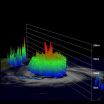(Press-News.org) On rare occasion, the light-sensing photoreceptor cells in the eye misfire and signal to the brain as if they have captured photons, when in reality they haven't. For years this phenomenon remained a mystery. Reporting in the June 10 issue of Science, neuroscientists at the Johns Hopkins University School of Medicine have discovered that a light-capturing pigment molecule in photoreceptors can be triggered by heat, as well, giving rise to these false alarms.
"A photon, the unit of light, is just energy, which, when captured by the pigment rhodopsin, most of the time causes the molecule to change shape, then triggering the cell to send an electrical signal to the brain to inform about light absorption," explains King-Wai Yau, Ph.D., professor of neuroscience at Johns Hopkins and member of its Center for Sensory Biology. "If rhodopsin can be triggered by light energy," says Yau, "it may also be occasionally triggered by other types of energy, such as heat, producing false alarms. These fake signals compromise our ability to see objects on a moonless night. So we tried to figure it out; namely, how the pigment is tripped by accident."
"Thermal energy is everywhere, as long as the temperature is above absolute zero," says neuroscience research associate Dong-Gen Luo, Ph.D. "The question is: How much heat energy would it take to trigger rhodopsin and enable it to fire off a signal, even without capturing light?" says Johns Hopkins Biochemistry, Cellular and Molecular Biology graduate student Wendy Yue.
For 30 years, the assumption was that heat could trigger a pigment molecule to send a false signal, but through a mechanism different from that of light, says Yau, because it seemed, based on theoretical calculations: that very little thermal energy was required compared to light energy.
But the theory, according to Yau, was based mainly on the pigment rhodopsin. However, rhodopsin is mainly responsible for seeing in dim light and is not the only pigment in the eye; other pigments are present in red-, green- and blue-sensitive cone photoreceptors that are used for color and bright-light vision. Although researchers are able to measure the false events of rhodopsin from a single rhodopsin-containing cell, a long-standing challenge has been to take measurements of the other pigments. "The electrical signal from a single cone pigment molecule is so small in a cone cell that it is simply not measurable," says Luo. "So we had to figure out a new way to measure these false signals from cone pigments."
By engineering a rod cell to make human red cone pigment, which is usually only found in cone cells, Yau's team was able to measure the electrical output from an individual cell and calculate this pigment's false signals by taking advantage of the large and detectable signals sent out from the cell.
As for blue cone pigment, "Nature did the experiment for us," says Yau. "In many amphibians, one type of rod cells called green rods naturally express a blue cone pigment, as do blue cones." So to determine whether heat can cause pigment cells to misfire, the team, working in the dark, first cooled the cells, and then slowly returned the cells to room temperature, measuring the electrical activity of the cells as they warmed up. They found that red-sensing pigment triggers false alarms most frequently, rhodopsin (bluish-green-sensing pigment) triggers falsely less frequently, and blue-sensing pigment does so even less.
"This validates the 60-year-old Barlow's hypothesis that suggested the longer wavelength the pigment senses—meaning the closer to the red end of the spectrum—the noisier it is," says Yau. And this finding led the team to develop and test a new theory: that heat can trigger pigments to misfire, by the same mechanism as light.
Pivotal to this theory is that visual pigment molecules are large, complex molecules containing many chemical bonds. And since each chemical bond has the potential to contain some small amount of thermal energy, the total amount of energy a pigment molecule could contain can, in theory, be enough to trigger the false alarm.
"For a long time, people assumed that light and heat had to trigger via different mechanisms, but now we think that both types of energy, in fact, trigger identical changes in the pigment molecules," says Yau. Moreover, since longer wavelength pigments have higher rates of false alarms, Yau says this may explain why animals never evolved to have infrared-sensing pigments.
"Apart from putting to rest a long-standing debate, it's a wake-up call for researchers to realize that biomolecules in general have more potential thermal energy than previously thought," says Luo.
###
This study was funded by the National Institutes of Health, the Antonio Champalimaud Vision Award and The Academy of Finland.
Authors on the paper are Dong-Gen Luo, Wendy Yue and King-Wai Yau, all of Johns Hopkins, and Petri Ala-Laurila of the University of Washington, Seattle.
On the Web:
King-Wai Yau: http://neuroscience.jhu.edu/KingWaiYau.php
Solomon H. Snyder Department of Neuroscience: http://neuroscience.jhu.edu/index.php
IBBS Center for Sensory Biology: http://www.hopkinsmedicine.org/institute_basic_biomedical_sciences/research/research_centers/sensory_biology/
END
Waterloo, Ontario, Canada, June 9, 2011 – A unique, international summit of scientists, engineers, entrepreneurs and future leaders from around the world has concluded with the release of the Equinox Summit: Energy 2030 Communiqué. The event's preliminary report includes visionary proposals for transformative action to reduce the electricity-related emissions that drive global warming.
The full Equinox Communiqué is now available at: http://wgsi.org/files/EquinoxCommunique_June9_2011.pdf
The Communiqué identifies a group of technological approaches and implementation ...
COLUMBUS, Ohio – A Detroit entrepreneur surprised university engineers here recently, when he invented a heat-treatment that makes steel 7 percent stronger than any steel on record – in less than 10 seconds.
In fact, the steel, now trademarked as Flash Bainite, has tested stronger and more shock-absorbing than the most common titanium alloys used by industry.
Now the entrepreneur is working with researchers at Ohio State University to better understand the science behind the new treatment, called flash processing.
What they've discovered may hold the key to making ...
WEST LAFAYETTE, Ind. - Researchers have developed a new type of imaging technology to diagnose cardiovascular disease and other disorders by measuring ultrasound signals from molecules exposed to a fast-pulsing laser.
The new method could be used to take precise three-dimensional images of plaques lining arteries, said Ji-Xin Cheng, an associate professor of biomedical engineering and chemistry at Purdue University.
Other imaging methods that provide molecular information are unable to penetrate tissue deep enough to reveal the three-dimensional structure of the plaques, ...
Recently EiDealCasino.com has made some improvements to give their web site a fresh new look, which makes easier and more fun to surf.
EiDealCasino.com is a casino guide that assists Netherlands casino players to find top sites offering quality games that accept payments using the method iDeal - ideal casino guide.
Eidealcasino.com aims to make locating top online casinos, effortless. Their goal is to provide the best up-to-date information for Netherlands with various internet casinos. The website has gathered extensive information on the most reputable and popular ...
The low pressure system that has been bringing rainfall to the northwestern Philippines has strengthened into the fifth tropical depression of the Northwest Pacific Ocean's hurricane season.
Tropical Depression 05W (TD05W) also known as Dodong in the Philippines was caught by infrared NASA satellite imagery on June 8 at 1741 UTC (1:41 p.m. EDT). The infrared data showed some powerful thunderstorms with very cold cloud top temperatures near the threshold of AIRS data of -63 Fahrenheit and -52 Celsius. That indicates the coldest, strongest thunderstorms within the tropical ...
An innovative new eGreetings website, www.iAttachments.com, officially opens for business today. For a $20 annual fee subscribers can send an unlimited number of greetings over the Internet. The distinctiveness of the service is 1) a short film with a song or a lyric video that tells a story appropriate for the greeting occasion, and 2) the core greeting is customized by the sender with an animated "envelope" preceding the film and an animated digital closing personalized with a message to the recipient follows
the film. Subscribers may also use the site's licensed ...
ST. PAUL, MN—Five years after the launch of a global effort to protect the world's most important food crop from variants of Ug99, a new and deadly form of wheat rust, scientists say they are close to producing super varieties of wheat that will resist the potent pathogen, while boosting yields by as much as 15 percent.
According to research to be presented at a global wheat rust symposium in Minneapolis starting June 13, scientists report that variants of the Ug99 strain of stem rust are becoming increasingly virulent and are being carried by wind beyond the handful of ...
What is Amazing Forest?
Yes, the Amazon rainforest is being cut down as you read this. 17% is already gone. The world's lungs - as it's referred to - is decreasing in size. Yes, everyone knows this. But what can we really do about it? The Amazing Forest is a chance to do something right from where you are, sitting in your chair, a few clicks and US$60 away.
Amazing Forest is the venue where people from all over the world are combining their efforts into one single strain to restore the Amazon rainforest to its original state.
We sell trees. Not trees to be delivered ...
Strong thunderstorms are the life's blood of tropical cyclones, and infrared and radar satellite data from NASA today confirms that the eastern Pacific Ocean's first hurricane has plenty of them and they're over 9 miles high. Adrian exploded in growth overnight from a tropical storm on June 8 to a major hurricane today.
NASA's Aqua satellite flew over Hurricane Adrian this morning at 8:29 UTC (1:59 a.m. EDT), and the Atmospheric Infrared Sounder instrument took an infrared snapshot of the storm's many strong thunderstorms and warm ocean water below.
The infrared data ...
New research shows how the protein missing in fragile X syndrome – the most common inherited form of intellectual disability – acts as a molecular toggle switch in brain cells.
The fragile X protein, called FMRP, hooks up with a group of molecules called microRNAs to switch the production of other proteins on and off in response to chemical signals, scientists at Emory University School of Medicine have discovered.
The results appear in the June 10 issue of Molecular Cell.
"For learning and memory to take place, neurons need to be able to make new proteins on demand, ...



